-
 Bitcoin
Bitcoin $115100
-2.99% -
 Ethereum
Ethereum $3642
-1.38% -
 XRP
XRP $3.027
-5.51% -
 Tether USDt
Tether USDt $1.000
-0.05% -
 BNB
BNB $763.4
-1.32% -
 Solana
Solana $177.2
-5.42% -
 USDC
USDC $0.9999
-0.02% -
 Dogecoin
Dogecoin $0.2247
-6.47% -
 TRON
TRON $0.3135
0.23% -
 Cardano
Cardano $0.7824
-4.46% -
 Hyperliquid
Hyperliquid $42.53
-0.97% -
 Stellar
Stellar $0.4096
-6.09% -
 Sui
Sui $3.662
-2.61% -
 Chainlink
Chainlink $17.63
-3.57% -
 Bitcoin Cash
Bitcoin Cash $536.3
2.94% -
 Hedera
Hedera $0.2450
0.34% -
 Avalanche
Avalanche $23.23
-3.15% -
 Litecoin
Litecoin $112.2
-1.23% -
 UNUS SED LEO
UNUS SED LEO $8.976
-0.30% -
 Shiba Inu
Shiba Inu $0.00001341
-2.72% -
 Toncoin
Toncoin $3.101
-2.44% -
 Ethena USDe
Ethena USDe $1.001
-0.05% -
 Uniswap
Uniswap $10.08
-1.97% -
 Polkadot
Polkadot $3.938
-2.77% -
 Monero
Monero $323.9
0.87% -
 Dai
Dai $0.9999
-0.02% -
 Bitget Token
Bitget Token $4.481
-1.69% -
 Pepe
Pepe $0.00001199
-5.94% -
 Aave
Aave $288.2
-0.68% -
 Cronos
Cronos $0.1279
0.36%
What does it mean when K-line breaks through Bollinger upper rail for three consecutive times?
Three consecutive K-line breakouts above the Bollinger upper band signal strong bullish momentum but may warn of overextension—confirm with volume, RSI, and MACD for reliable trading decisions.
Jul 24, 2025 at 04:43 pm
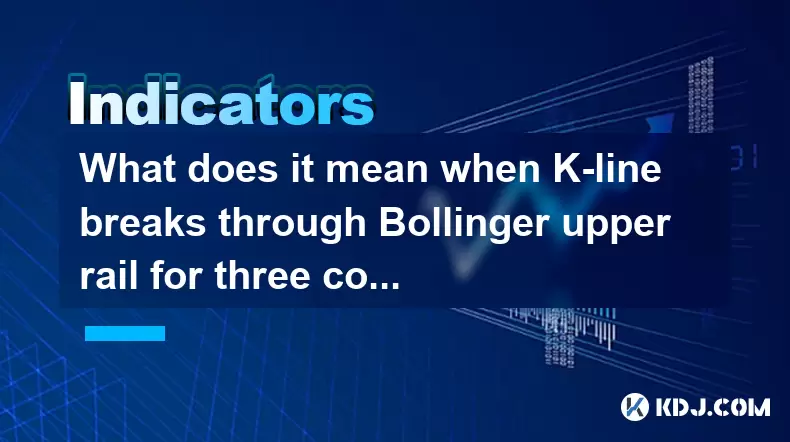
Understanding Bollinger Bands and K-line Basics
Bollinger Bands are a widely used technical analysis tool in the cryptocurrency trading space. They consist of three lines: the middle band, typically a 20-period simple moving average (SMA); the upper band, which is the middle band plus two standard deviations; and the lower band, the middle band minus two standard deviations. These bands dynamically expand and contract based on market volatility. The K-line, also known as a candlestick chart, represents price movement over a specific time interval, showing open, high, low, and close prices.
When traders observe a K-line breaking through the Bollinger upper rail, it indicates that the closing price of that period has exceeded the upper boundary of the Bollinger Band. This often suggests overbought conditions or a strong bullish momentum. However, a single breakout may not carry significant weight. When such a breakout occurs three consecutive times, it raises important questions about market sentiment, trend strength, and potential reversals.
Interpreting Three Consecutive Breakouts Above the Upper Band
When the K-line breaks through the Bollinger upper rail three times in a row, it signals persistent upward price pressure. Each breakout reflects that buyers are consistently pushing the price beyond the statistically expected range. In technical terms, this could indicate that the market is entering a phase of extended momentum. However, it's critical to assess whether this reflects a sustained trend or an impending reversal.
- First breakout: May suggest the start of a strong bullish move, possibly triggered by positive news or increased buying volume.
- Second breakout: Reinforces the bullish trend, showing that the momentum is not a one-time spike.
- Third breakout: Raises caution, as repeatedly exceeding the upper band may indicate overextension.
Each breakout should be analyzed in the context of volume, candlestick patterns, and broader market conditions. High trading volume during these breakouts supports the legitimacy of the move. Conversely, diminishing volume may hint at weakening momentum.
Role of Volatility in Repeated Upper Band Breakouts
Volatility plays a central role in how Bollinger Bands behave. The bands widen during high volatility and contract during low volatility. When a cryptocurrency asset experiences three consecutive breakouts, it often coincides with a period of increasing volatility. This expansion can be triggered by major events such as exchange listings, regulatory news, or macroeconomic shifts.
- If the bands are widening, the breakouts may reflect genuine market enthusiasm and a potential continuation of the uptrend.
- If the bands are narrowing before the breakouts, it could suggest a "squeeze" breakout, where pent-up energy is released, leading to a strong directional move.
Traders should monitor the Bandwidth indicator, which measures the distance between the upper and lower bands. A rising Bandwidth confirms increasing volatility, adding credibility to the repeated breakouts.
Confirming Signals with Additional Indicators
Relying solely on Bollinger Bands can lead to false signals. To validate the significance of three consecutive upper band breakouts, traders should incorporate complementary technical tools.
- Relative Strength Index (RSI): Check if RSI is above 70. If so, the asset may be overbought, increasing the likelihood of a pullback.
- Moving Average Convergence Divergence (MACD): Look for bullish MACD crossovers or increasing histogram bars to confirm momentum.
- Volume Profile: Ensure that each breakout is supported by rising volume. A breakout on low volume is less reliable.
- Support and Resistance Levels: Identify if the price is approaching a known resistance zone. A breakout near resistance may fail without strong confirmation.
For example, if RSI is above 80 and MACD begins to flatten, the three breakouts may signal exhaustion rather than strength. Conversely, if MACD remains bullish and volume surges, the uptrend may continue.
Practical Trading Strategy for Triple Upper Band Breakouts
Traders can develop a structured approach to respond to this pattern. The following steps outline a detailed operational framework:
- Step 1: Identify the first breakout by checking if the closing price exceeds the upper Bollinger Band for a full period (e.g., 1-hour candle).
- Step 2: Wait for the second breakout, ensuring the candle closes above the upper band again.
- Step 3: Monitor the third breakout with attention to candlestick shape—long upper wicks may indicate rejection.
- Step 4: Check volume on each breakout candle; volume should be equal or higher than the previous breakout.
- Step 5: Set a limit entry order slightly above the third breakout candle’s high if confirming continuation.
- Step 6: Place a stop-loss below the middle Bollinger Band or recent swing low to manage risk.
- Step 7: Use a trailing stop or partial profit-taking at key Fibonacci extension levels (e.g., 1.618).
This strategy works best in trending markets and should be avoided during sideways or choppy conditions. Always backtest the approach on historical data using platforms like TradingView or MetaTrader.
Psychological and Market Sentiment Implications
The three consecutive breakouts also reflect trader psychology. The first breakout attracts momentum traders. The second encourages trend followers. The third may trigger FOMO (fear of missing out), drawing in late buyers. However, smart money may begin taking profits at this stage, anticipating a pullback.
Market sentiment tools like funding rates (in futures markets) can provide insight. If funding rates are highly positive, it suggests excessive long positions, increasing the risk of a short squeeze or reversal. Similarly, open interest rising with price supports continuation, while flat or declining open interest during breakouts may signal weak participation.
Frequently Asked Questions
Q: Does a third breakout above the Bollinger upper band always lead to a reversal?
No, a third breakout does not guarantee a reversal. It may indicate continued strength if supported by high volume, bullish MACD, and widening bands. Reversal signs include bearish candlestick patterns (e.g., shooting star), overbought RSI, and declining volume.
Q: Can this pattern occur in bear markets?
Yes, even in a bear market, short-term rallies can cause temporary breakouts above the upper band. These are often short-covering bounces and tend to fail quickly. Always assess the higher timeframe trend before interpreting the signal.
Q: How should I adjust Bollinger Band settings for this analysis?
The default 20-period SMA and 2-standard deviation settings are recommended. Changing these may distort the statistical meaning. For volatile cryptos like Bitcoin or Ethereum, the default settings work well across 1H, 4H, and daily charts.
Q: What timeframes are most reliable for observing triple breakouts?
The 4-hour and daily charts provide the most reliable signals. Lower timeframes (e.g., 5-minute) generate frequent false breakouts due to noise. Always confirm with higher timeframe alignment.
Disclaimer:info@kdj.com
The information provided is not trading advice. kdj.com does not assume any responsibility for any investments made based on the information provided in this article. Cryptocurrencies are highly volatile and it is highly recommended that you invest with caution after thorough research!
If you believe that the content used on this website infringes your copyright, please contact us immediately (info@kdj.com) and we will delete it promptly.
- Crypto ETFs: Analyzing the 2025 Boom and Beyond
- 2025-07-26 00:30:12
- Bitcoin Swift (BTC3): Last Call for Presale Stage 1!
- 2025-07-25 23:10:12
- Altcoins of the Decade: Unearthing the Top 3 Crypto Titans
- 2025-07-25 23:50:11
- Bitcoin, Presales, and Crypto Buys: What's Hot in the NYC Crypto Scene?
- 2025-07-25 23:50:11
- BlockDAG, LINK, and Uniswap: Navigating the Crypto Landscape with Real-World Utility
- 2025-07-25 23:55:12
- Tyre Legalities and the 20p Coin Test: What Motoring Experts Want You to Know
- 2025-07-25 23:55:12
Related knowledge
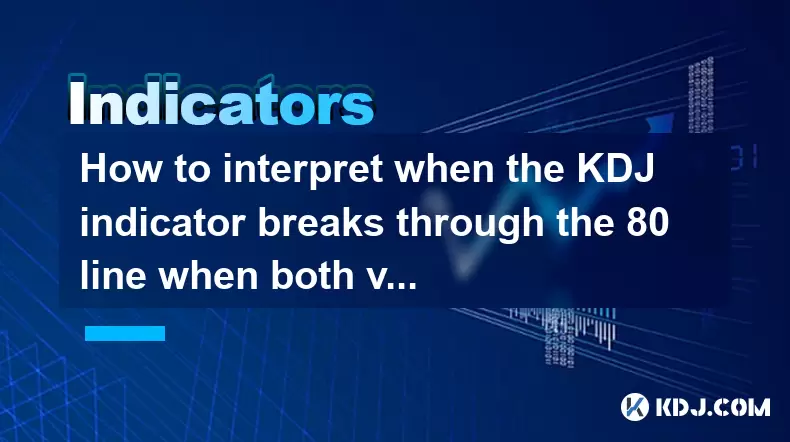
How to interpret when the KDJ indicator breaks through the 80 line when both volume and price rise?
Jul 26,2025 at 12:47am
Understanding the KDJ Indicator and Its ComponentsThe KDJ indicator is a momentum oscillator widely used in technical analysis within the cryptocurren...
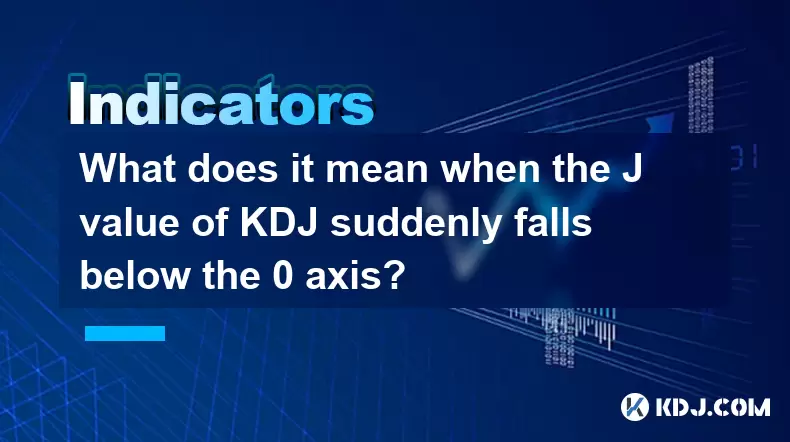
What does it mean when the J value of KDJ suddenly falls below the 0 axis?
Jul 26,2025 at 12:01am
Understanding the KDJ Indicator in Cryptocurrency TradingThe KDJ indicator is a momentum oscillator widely used in cryptocurrency trading to identify ...

How to interpret that the KDJ D line is downward for a long time but the price is sideways?
Jul 25,2025 at 07:00pm
Understanding the KDJ Indicator and Its ComponentsThe KDJ indicator is a momentum oscillator widely used in cryptocurrency trading to assess overbough...
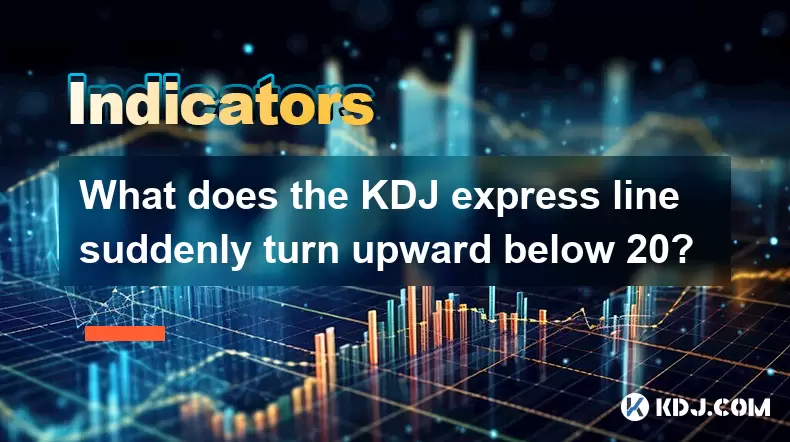
What does the KDJ express line suddenly turn upward below 20?
Jul 25,2025 at 11:49pm
Understanding the KDJ Indicator in Cryptocurrency TradingThe KDJ indicator is a momentum oscillator widely used in cryptocurrency trading to identify ...
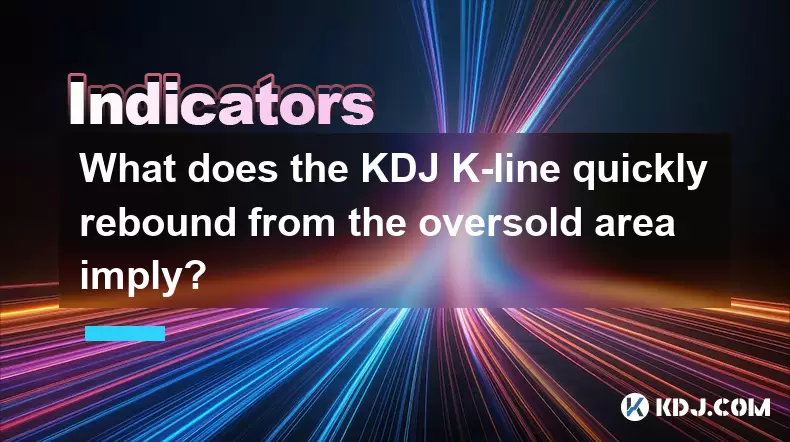
What does the KDJ K-line quickly rebound from the oversold area imply?
Jul 26,2025 at 12:21am
Understanding the KDJ Indicator in Cryptocurrency TradingThe KDJ indicator is a momentum oscillator widely used in cryptocurrency trading to identify ...

What does it mean that the KDJ indicator forms a double bottom at a low level?
Jul 25,2025 at 05:08pm
Understanding the KDJ Indicator in Cryptocurrency TradingThe KDJ indicator is a momentum oscillator widely used in cryptocurrency trading to identify ...

How to interpret when the KDJ indicator breaks through the 80 line when both volume and price rise?
Jul 26,2025 at 12:47am
Understanding the KDJ Indicator and Its ComponentsThe KDJ indicator is a momentum oscillator widely used in technical analysis within the cryptocurren...

What does it mean when the J value of KDJ suddenly falls below the 0 axis?
Jul 26,2025 at 12:01am
Understanding the KDJ Indicator in Cryptocurrency TradingThe KDJ indicator is a momentum oscillator widely used in cryptocurrency trading to identify ...

How to interpret that the KDJ D line is downward for a long time but the price is sideways?
Jul 25,2025 at 07:00pm
Understanding the KDJ Indicator and Its ComponentsThe KDJ indicator is a momentum oscillator widely used in cryptocurrency trading to assess overbough...

What does the KDJ express line suddenly turn upward below 20?
Jul 25,2025 at 11:49pm
Understanding the KDJ Indicator in Cryptocurrency TradingThe KDJ indicator is a momentum oscillator widely used in cryptocurrency trading to identify ...

What does the KDJ K-line quickly rebound from the oversold area imply?
Jul 26,2025 at 12:21am
Understanding the KDJ Indicator in Cryptocurrency TradingThe KDJ indicator is a momentum oscillator widely used in cryptocurrency trading to identify ...

What does it mean that the KDJ indicator forms a double bottom at a low level?
Jul 25,2025 at 05:08pm
Understanding the KDJ Indicator in Cryptocurrency TradingThe KDJ indicator is a momentum oscillator widely used in cryptocurrency trading to identify ...
See all articles

























































































